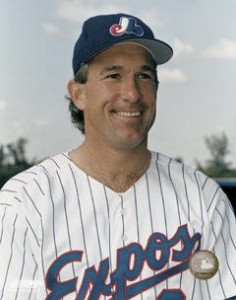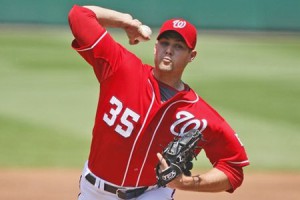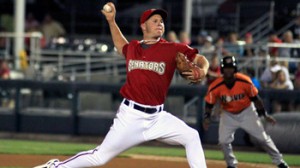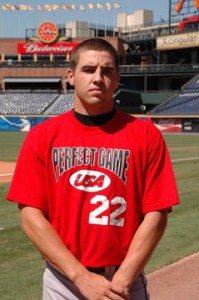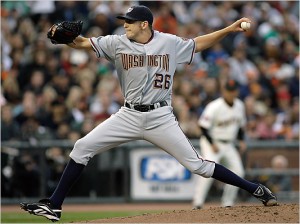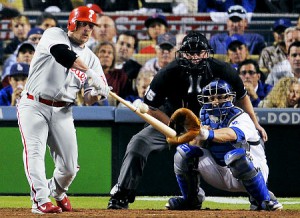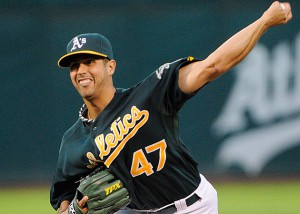
Is it too early to guess who starts the Home Opener? My guess is newly acquired Gonzalez. Photo Thearon W. Henderson/Getty Images via cbssports.com
We’re getting reports of players getting to Viera early, and we’ve had a slew of off-season moves. Beat reporters are starting to talk about the 25-man roster (here’s WT’s Amanda Comak‘s take). The Nats pretty much took care of every off-season need the had:
- Top-end Starting Pitcher: Gonzalez
- Backup Outfielder: Ankiel and Cameron (though, apparently Cameron is retiring instead of competing for a spot…)
- Lower-end Starting Pitchers: Re-signed Wang, signed Jackson
- Utility Infielders to replace Cora, Bixler, Hairston: signed DeRosa, claimed Rivera
- Bullpen arm depth (to replace Coffey, Kimball): signed Lidge, traded for Perry
The notable exception to the off-season shopping list, of course, is a lack of a proven center fielder. Perhaps one could quibble that a shortstop should have been on that list; it seems the team is giving another year to the Ian Desmond experiment, hoping he builds on the strong end of 2011 (he hit .294 in Aug and Sep of 2011). The backup infielders and backup outfielders listed here, to go along with a slew of minor league/invite to spring training signings, should be where most of the competition for roster slots occurs.
The big question for me is; Is there any real competition for pitching spots this spring?
Starters
We all know the narrative; we now have 6 starters with multi-million dollar commitments for 5 spots, and someone has to give. The Edwin Jackson signing has pretty much made John Lannan the odd-man out of this rotation. Mike Rizzo likes power arms, and has gone to great lengths to acquire guys who throw more than 89-90 to replace what he inherited in 2009. Wang and Jackson can’t be moved until June 15th without his consent by virtue of the FA signing rules (as discussed in this article here), Gonzalez just signed a long-term deal, and Strasburg/Zimmerman are our future. To me, there’s no mystery who’s going to be in the rotation, and frankly articles that say there’s going to be a competition for the 5th starter between Wang, Lannan, Detwiler and Gorzelanny are not really paying attention to the contract realities of the situation. Barring injury, your opening day rotation will be (in this order):
- Strasburg, Gonzalez, Zimmermann, Jackson and Wang.
Should someone go down with injury, Lannan steps in to take the 4th or 5th rotation spot (depending on whether Davey Johnson likes to mix up LHSP/RHSP in any fashion). Otherwise, Lannan is trade-bait and should be moved during the spring. There are plenty of teams that could be trade partners if we wanted to focus on a center fielder (see this article I did in November talking about the CF market for the whole of baseball for some thoughts). Barring a trade, it seems inconceivable but Lannan does still have a minor league option left and could be sent down, but a $5M pitcher toiling in Syracuse (to go along with $2M bust Yuniesky Maya) could make the Nats AAA team the most expensive minor league rotation in the league. (We won’t say “most expensive ever,” since the Yankees kept Kei Igawa and his $46M commitment in the minors for most of his contract).
Relievers
A recent post on option status at Nationalsprospects.com (the option status of every player is now kept on the Big Board, which is good for me since I did this work last year and its a nightmare to keep track of), as well as a question asked of Bill Ladson leads to this conclusion: there literally is no question right now who your 7 bullpen members will be. Tyler Clippard, Sean Burnett, Henry Rodriguez, Tom Gorzelanny and Ross Detwiler ALL are out of options. Brad Lidge can refuse a demotion based on his service time and Drew Storen is your closer. There’s your 2012 bullpen; not much room for anyone else.
The only wiggle room may be with someone like Detwiler: he’s clearly a starter and seems set to be the first Spot starter to fill in for an injury (assuming we trade Lannan of course). Does the team keep him in the bullpen, where he basically fills the exact same role as Gorzelanny (ex-left handed starter long man/spot starter in a pinch)? Or does the team cash him in to fill a hole?
This configuration leaves newly acquired Ryan Perry, Ryan Mattheus and Atahualpa Severino in AAA. Cole Kimball starts on the 60-day DL (and, frankly, probably stays there; the odds of him coming back from that shoulder injury are low). Lastly Craig Stammen joins Maya in AAA as deep-need emergency starters.
So, here’s your bullpen:
- Closer: Storen
- Setup: Clippard
- 7th inning guys: Lidge, Rodriguez
- Loogy: Burnett
- Long Men: Gorzelanny and Detwiler
What’s nice about this bullpen is that, despite my naming players to roles, there’s lots of flexibility. Rodriguez on a good day has 8th or even 9th inning stuff. Lidge is a former closer and clearly can do the setup or closing roles. Clippard excels in the 8th inning role and doesn’t seem to aspire to replace Storen. Burnett is far more than just a one-out guy, but can serve that role in a pinch. Lastly both Gorzelanny and Detwiler can be anything from a one-out lefty to a 3-4 inning mop-up guy, given the day. I like the way this sets up and I think we go into 2012 with a better bullpen than in 2011 (when, if you recall, we wasted a spot on Brian Broderick, had the failure of Doug Slaten in the loogy role and watched Chad Gaudin pitch horribly).
Who starts the Home opener?
Quick guess: based on the way the schedule plays out it looks like our home opener will be thrown by our #2 starter Gonzalez. We play two 3-game series away to Chicago and New York, then open at home with what should be the #2 rotation spot up. There’s only one off-day in between, meaning the starters most likely stay on normal rest.



